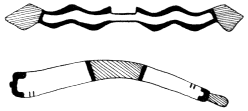Wands.
—The priest leaders carry several different feather wands. These are the insignia of the kiva or organization which happens to be performing. Moreover, these brilliantly clothed fetishes are works of art by reason of the careful selection and arrangement of feathers and the remarkable precision with which each feather is bound in place.
There is a lightning wand which is cut from wood in a zigzag shape to imitate that phenomenon of nature. It is carried by certain impersonators in dances devoted to rainmaking.[78] The quick striking of the lightning is represented to the Indian mind by a mechanized frame of strips of wood, pegged or tied together like a lazy tongs, folded and unfolded by two handles at one end.[79] This is one of their most highly developed mechanical devices, and the ceremonial lightning thus created never fails to inspire the spectators with wonder and amazement. Representations of lightning end in arrow-shaped points because the Pueblo Indian believes that each flash is tipped with a stone knife.[80]
Warriors and those concerned with the hunt always carry brightly painted, curved rabbit sticks or bows and arrows trimmed with downy eagle feathers which float from the tips and interspacings along the strings. Sprigs of evergreen are carried in the hand, parallel to the bow.
At Santa Clara a section of gourd is mounted on a short stick and carried by each male dancer in the Zuñi Basket Dance. This piece of gourd is painted green on the concave surface and decorated with four eagle feathers. It is said to represent the sun, especially when stick and emblem are held aloft.[81]

Figure 22.
Hopi dance wands: upper, lightning dance
wand; lower, rabbit-stick dance wand.
The women's dance wands are rectangular tablets with a handle at one end. In dancing for rain these are carried vertically in each hand. A single, wide tablet may have two handles side by side; it is then carried with both hands in front of the body.[82] In the center is painted a figure of a rain god with curving cloud shapes and streaks of rain above him and a stylized ear of corn below. The whole is topped with downy feathers and crisp yellow heads of seed grass, and puffs of eagle down float at intervals from each side. At Zuñi another hand wand, of great beauty, is carried. It is made of slender sticks "about eighteen inches long, painted white and adorned with delicate white duck feathers in groups of two, the space between being the width of the first three fingers placed crosswise within a few inches of their ends".[83] There are also little, formal bouquets made of feathers beautifully arranged with respect to color and size, and having borders of evergreens and a final edging of shells or dainty, bone-colored dewclaws of the deer or antelope (pl. 22).
Many of the dancers carry tall staffs to indicate their office or to give

Plate 24.
Eagle Kachina, Hopi. Bird form stylized by introduction
of all the elements of the conventional kachina costume.
dignity to their impersonations (pls. 29, 30). The staffs are variously ornamented with feathers, evergreen, cornhusks, ears of corn, and other sacred symbols.